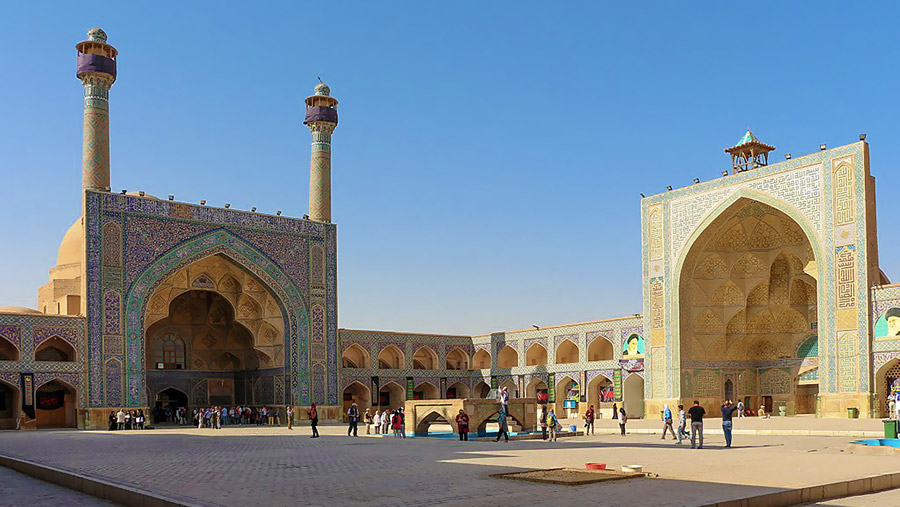 Signin with Google
Signin with Google Signin with Facebook
Signin with Facebook

 Places,Culture,History
Places,Culture,HistoryJame Mosque of Isfahan over Twelve Century of History

Passing through the intricate lanes of the Grand Bazaar of Isfahan, the ancient glorious capital of the Safavid era, leads to the entrance of one of the city's most astonishing monuments: the Jameh Mosque.
Over 20000 square meters, this unique complex is one of the most important mosques in Iran and Islamic art. There is almost 2000 years of construction behind it, starting in the 8th century, which makes it one of the oldest mosques in Iran. It is said that before being a mosque, this place might have been a Zoroastrian temple. What makes it so unique is precisely the numerous evolutions over the centuries, and under four dynasties, of this congregational mosque.
A unique testimony of Persian history and architecture
The Jameh Mosque is the harmonious result of several reconstructions over time, additions and renovations, incorporating decorative elements of the various dynasties, from the Mongols to the Timurids and the Safavids. Thus it's not only a delight for the eyes, with its beautiful blue-tiles mosaics and domes, but it's also a blend of Iranian history and the true embodiment of Persian architecture.
The first stones were put under the Abbasid Caliphate in the 8th century. In the following century, another mosque was built at the same location and the Buyid Dynasty started to make the first extensions. But the mosque's core structure primarily dates back to the 11th century, under the great Seljuk Dynasty, which established Isfahan as their capital. At that era, the Turko-Persian Seljuk Empire dominated a region which stretched from Anatolia to the west of China.

Four splendid vaulted gates
In their third capital Isfahan, they reshaped the Jameh Mosque with its most important and stunning architectural features. They added new prayer rooms, with elaborated and delicate brickwork, but moreover, they built the mosque according to a plan which would become a prototype for Iranian and Central Asian's mosques. This new architecture includes four iwans facing each other, around a tranquil opened central courtyard.
The iwans are the most iconic features of this mosque and are still used nowadays in Iranian mosques. An iwan is a gracious vaulted space, which opens on one side to the courtyard. These enormous opened arched face each other on the north, south, east, and west sides. Developed in Pre Islamic Iran, they were mainly used in monumental and imperial architecture. But in Isfahan's Jameh Mosque, they became for the first time part of an Islamic religious building.
Constantly embellished until the Qajar dynasty
On the southern side of the mosque, the Qibla Iwan, which indicates the direction of Mecca, is surrounded by two thin blue minarets. This recognizable element was meant to easily find the direction of prayer within the mosque. These four massive portals have been decorated with the finest Persian tilework. They are covered with sumptuous ceramic designs, arabesques and calligraphies, assembled pieces by pieces by the most skilled craftspeople of that time. The elaborate ornamentation of the iwans contrasts with the simplicity and sobriety of the mosque's decoration.
Seljuk's contribution to this masterpiece, listed by UNESCO in 2012 as a world heritage member, is also visible by the addition of beautiful double-shelled ribbed domed. Later Safavid and Qajar added the last embellishment touch which made this place the stunning building we can now observe today.

Not only a place for prayer
As a congregational mosque, it was the city's most important religious place, where all inhabitants would gather on Friday to join the prayer. Because of its central location, at the heart of one of Persia's greatest capital, it was not only a religious place. One has to walk through the small alleys of the old city centre to find the mosque. Surprisingly, it shares walls with the bazaar and other buildings around. Numerous entrances have been made to access the mosque from different directions within the market so that it became a real pedestrian hub.
Such urban integration is truly unique throughout Iran, and as a consequence, it also turned the Jameh Mosque into a centre of the political, commercial, and social life of Isfahan. Still located at the heart of the buzzing life of the city, it has remained a significant place for all Isfahani people. Every Friday, the Jameh Mosque still echoes with the prayers of the faith.
